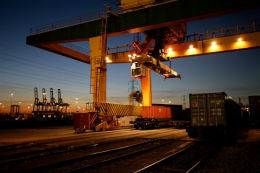Posted 1st April 2009 | 1 Comment
£55m project will improve clearances on port route

Southampton Freightliner terminal is set to move more cube containers following route improvements.
ONE of the UK’s busiest freight routes is set to become the centre of a major £55 million project to allow easier transport of bigger containers.
Work has already started on improving the gauge clearance on the Southampton to West Coast main line route via Reading and Nuneaton to what is known as W10 level.
This will mean it can be used throughout for the transport of the 9ft 6ins high containers now favoured by shipping companies. It will also cater for freight growth in the future.
Currently, freight operators have to use special low wagons to carry the W10 ‘cubes’ and want to be able to use standard container wagons to improve efficiency.
Infrastructure changes will involve around 50 different enhancement schemes through- out the route, some meaning that bridges have to be heightened or track bed lowered. Line closures are expected at times.
One of the biggest of the tasks in the early part of the project will be gauging work in the Southampton tunnel, which is programmed for December this year.
The overall multi-million pound project – which fits into a strategic freight network – is expected to take until 2011 and is being funded chiefly from the Department for Transport’s Transport Innovation Fund (TIF), Network Rail and third parties.
The enhancements to take place are based on the findings of the 2007 Freight RUS – Rail Utilisation Study – published by Network Rail.
The RUS identified the improvement project, to be carried out between 2009–2014, with W10 clearance of the core route from Southampton via Eastleigh, Reading West Junction, Leamington Spa and Nuneaton (WCML).
It states that most of the route, which takes in Oxford and Banbury, is two-track and handles some eight million tonnes of freight a year, with some 30 trains a day running between Southampton and Reading and into Birmingham.
The route is said to be the highest priority core W10 route in the country and freight operators have been pressing for action for some time.
The utilisation study in 2007 forecast six additional trains per day in the busier direction by 2014/15 and listed some of the areas where there are capacity problems.
- Southampton to Basing-stoke: Only two freight paths per hour available between off-peak passenger services.
- Conflicting freight and passenger movements at Reading West Junction.
- Crossing movements at Coventry.
- Conflicting movements between freight and passenger empty stock paths in the Oxford station area.
One of the biggest conflicts to movements, at Reading West Junction, is expected to be solved in the next few years as part of the £425 million transformation of Reading station and its trackwork.
A flyover will be built as part of the phase two work to allow freight and passenger trains to clear the station without conflict.
In a foreword in the Freight RUS, Network Rail said: “One of the key demands of the rail freight industry has been for gauge enhancement to allow greater access to the network for the increasingly common ‘high cube’ 9ft 6ins W10 containers.
“This strategy recommends the enhancement of a number of routes to allow W10, including those from the West Coast main line to the ports at Southampton and Felixstowe.”
The document went on to state that generating routes to W10 gauge would enable the growth of rail’s share of the market for the haulage of 9ft 6ins containers, enabling the railway to carry a ‘significant’ volume of traffic that would otherwise be carried by road hauliers.
Freightliner, the rail freight company which moves containers out of and into Southampton, has seen big growth in container traffic from the port but has to use either low liner wagons – with small wheels – or pocket wagons to move 9ft 6 ins containers to destinations.
A spokeswoman for the company said: “We cannot use normal container wagons at the moment so we will really welcome the start of work on gauge enhancement. It will be a more efficient operation and enable us to move more cube containers.
“This is a key route for us, so the work will be well worth it.”
Reader Comments:
Views expressed in submitted comments are that of the author, and not necessarily shared by Railnews.

HH, Birmingham
The route from Leamington to Coventry is single line for most of thw way and is a serious constraint to passeneger and freight. Doubling the single line sections would not be expensive. It would increase freight and passenger capacity, Allow the re-opening of the Kenilworth station with a local passenger service from Leamington to Nuneaton.
The other bottleneck on the route is the section through Coventry station requiring the crossing of the busy Rugby to Birmingham line with pendolinos every few minutes. The best solution here would be to build a single track 'dive under.from platform 4 underneath the Birmingham tracks and onto the Nuneaton line. It would be very tight but could be done and platform 4 could still be used for services to Birmingham.